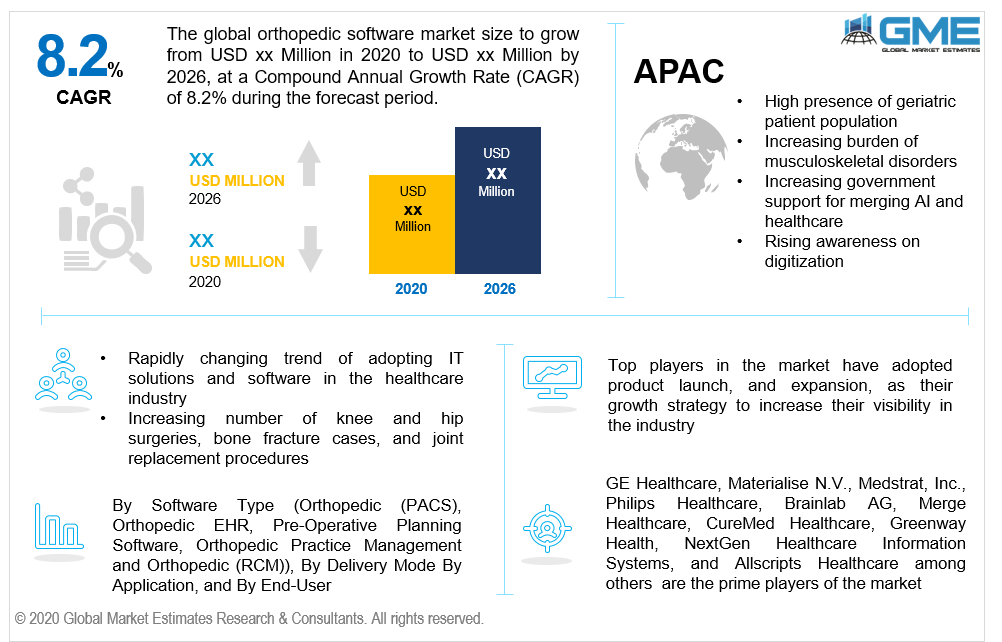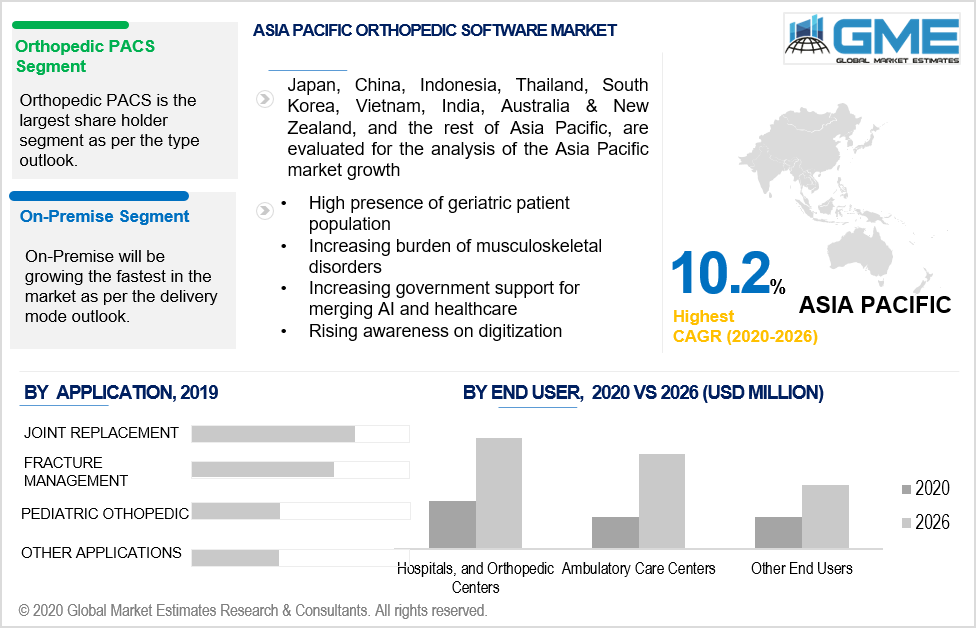
Global Orthopedic Software Market Size, Trends & Analysis - Forecasts to 2026 By Software Type (Orthopedic Picture Archiving and Communication Systems (PACS), Orthopedic Electronic Health Records, Pre-Operative Planning Software, Orthopedic Practice Management and Orthopedic Revenue Cycle Management (RCM)), By Delivery Mode (On-Premise, and Cloud-Based), By Application (Bone Replacement Management, Fracture Management, Pediatric Orthopedic Care Management and Other Applications), By End-User (Hospitals, & Orthopedic Centers, Ambulatory Care Centers and Other End Users), By Region (North America, Asia Pacific, CSA, Europe, and the Middle East and Africa); End-User Landscape, Company Market Share Analysis, and Competitor Analysis
The rising geriatric patient population, an increasing number of knee and hip surgeries, bone fracture cases, joint replacement procedures, increasing demand for merging AI in the healthcare industry, and the rising preference for minimally invasive treatments are a few of the major drivers of the orthopedic software market. Orthopedic doctors and surgeonsare increasingly using this software which is also known as pre-operative planning software systems. This software is designed to plan adigital pre-operative procedure and workflow for orthopedic surgeries.

The market can be segregated Orthopedic Electronic Health Records, Orthopedic Picture Archiving and Communication Systems Pre-Operative Planning Software, Orthopedic Revenue Cycle Management (RCM), and Orthopedic Practice Management. The orthopedic PACS segment will contribute the most in terms of the number of installations and revenue generation. This is mainly due to the cost friendliness of the product, efficient execution support for tedious bone surgeries, and its high availability amongst orthopedic across the globe.
The delivery mode for such software comes in two ways, namely on-premise, and cloud-based.The on-premise based software will be the dominant one majorly due to high data security and smooth patient information management.
Jointreplacement management, Pediatric orthopedic care managementfracture management, and other applicationsare the major applications of this market. The joint replacement application segment is ought to be the major segment in the market, mostly due to the high incidence of hip and knee replacement injuries and an increasing number of such surgeries.
Hospitals &orthopedic centers and ambulatory care centersare the major end-users of the market. Hospitals & orthopedic centers are the major end-users of this product owing to the rising number of patient registration in both IPD and OPD settings of the hospitals & clinics.

As of 2019, North America is estimated to be the largest market by region for orthopedic software. However, from 2020 to 2026, it is estimated that the Asia Pacific region will be growing faster than other regions such as North America, Europe, Middle East & South Africa, and Central & South America, owing to major drivers such asthe high presence of geriatric patient population, increasing burden of musculoskeletal disorders, rising awareness on digitization, and increasing government support for merging AI and patient report data.
GE Healthcare, Materialise N.V., Medstrat, Inc., Philips Healthcare, Brainlab AG, Merge Healthcare, CureMed Healthcare, Greenway Health, NextGen Healthcare Information Systems, and Allscripts Healthcareamong others are the prime players of the market.
Please note: This is not an exhaustive list of companies profiled in the report.
Recently in 2020, MTBC successfully acquired CareCloud Corporation, to expand its product portfolio and geographic presence with the help of robust products of CareCloud Corporation.
We value your investment and offer free customization with every report to fulfil your exact research needs.
The Global Orthopedic Software Market has been studied from the year 2017 till 2026. However, the CAGR provided in the report is from the year 2018 to 2026. The research methodology involved three stages: Desk research, Primary research, and Analysis & Output from the entire research process.

The desk research involved a robust background study which meant referring to paid and unpaid databases to understand the market dynamics; mapping contracts from press releases; identifying the key players in the market, studying their product portfolio, competition level, annual reports/SEC filings & investor presentations; and learning the demand and supply side analysis for the Orthopedic Software Market .

The primary research activity included telephonic conversations with more than 50 tier 1 industry consultants, distributors, and end-use product manufacturers.

Finally, based on the above thorough research process, an in-depth analysis was carried out considering the following aspects: market attractiveness, current & future market trends, market share analysis, SWOT analysis of the companies and customer analytics.

Tailor made solutions just for you
80% of our clients seek made-to-order reports. How do you want us to tailor yours?
OUR CLIENTS